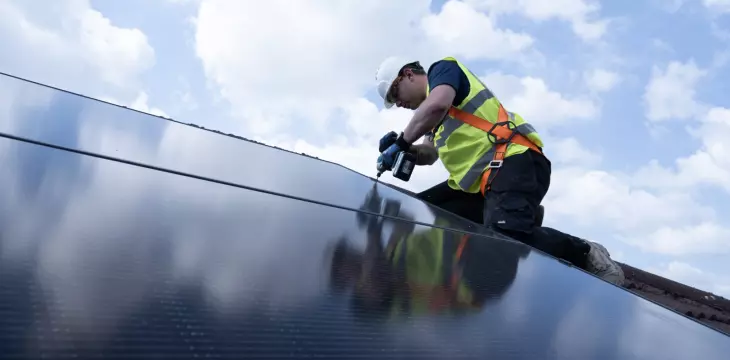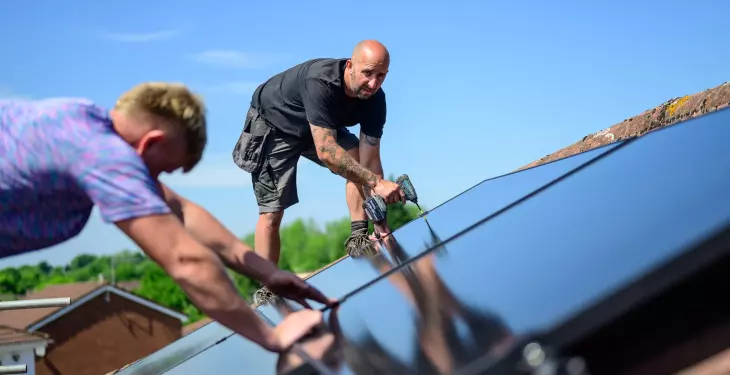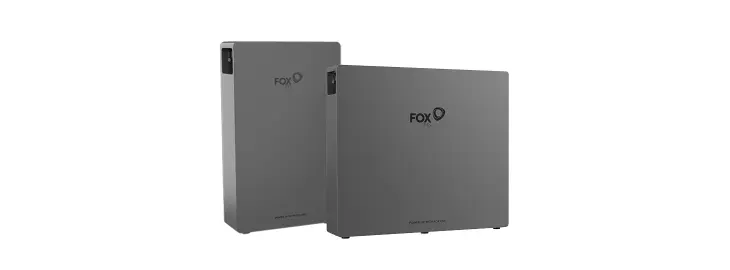

Written by Bethany Armstrong
Renewables Manager
Updated: 14th November, 2025
In this guide we compare key panel types and specs for UK homes, outline typical installed prices, and show how to match panels with reliable inverters and batteries for better savings.
See how much you could save with a solar & battery quote.
Choosing the best solar panels in the UK in 2025 comes down to matching efficiency, roof space and budget.
This guide compares the key panel types and specs for UK homes, outlines typical installed prices, and explains how to pair panels with reliable inverters and batteries to maximise savings.
It reflects systems iHeat designs and installs, including Aiko panels plus Fox ESS and Tesla storage.
Quick comparison table
These picks reflect common UK home needs in 2025. Prices are typical installed ranges for guidance, not quotes.
Pick | What it is | Typical panel wattage | Module efficiency | Look | Warranty (product / performance) | Ideal for | Typical installed price (no battery) |
Best overall | Aiko N-type all-black | 420-460 W | ~21-23% | Deep black | 25 yrs / up to 30 yrs | Most UK roofs, performance + aesthetics | £6,000-£9,000 for -4-5 kW |
Best for small roofs | Premium high-efficiency N-type | 440-460 W | ~22%+ | All-black | 25 yrs / up to 30 yrs | Limited space, high yield per m² | £6,500-£9,500 for -4-5 kW |
Best value | Reliable N-type TOPCon | 400-435 W | ~20-22% | Black frame or all-black | 20-25 yrs / 25-30 yrs | Lower cost per kW, balanced spec | £5,500-£8,000 for -4-5 kW |
Best for shade-tolerance | Half-cut, multi-busbar N-type | 400-440 W | ~20-22% | All-black | 20-25 yrs / 25-30 yrs | Chimneys, trees, mixed roof aspects | £6,000-£9,000 for -4-5 kW |
Before picking brands or models, make sure the fundamentals match your home and goals.
Module efficiency tells you how much of the sun’s energy a panel turns into electricity.
Premium residential panels sit around 21 to 23% in 2025. Find out more on how solar panels work in UK weather.
Wattage is the panel’s power rating under test conditions. For UK roofs, you will often see 400 to 460 W per panel.
Small roofs benefit most from higher efficiency, since you get more kW per square metre and fewer panels for the same output.
Many homeowners want all-black modules with a black frame and black backsheet for a clean, uniform look.
If your roof is awkwardly shaped, panel dimensions and clamp zones matter.
A smart layout can outperform a higher headline wattage if it fits the roof better.
UK weather is cooler than southern Europe, which helps panels. Check the temperature coefficient.
A lower figure (for example around -0.30%/°C) means less output drop on hot days.
Look for a 25-year product warranty and 30-year performance warranty from premium modules.
Good performance warranties typically promise around 88-90% of original output at year 30 for the best panels.
UK roofs often see partial shade from chimneys, trees, or neighbouring buildings.
Half-cut cells, multi-busbar designs, and three junction boxes can help reduce shade losses.
Your designer can also use module-level optimisation if shade is complex, although it adds cost.
Panels are one piece of the system.
The inverter, battery, mounting hardware, cabling, and the design determine real-world results.
Choose proven inverters and intuitive monitoring apps.
iHeat frequently fits Fox ESS hybrid inverters and Tesla Powerwall for storage because they integrate well and are easy to live with.
Why they stand out
Aiko’s high-efficiency N-type technology delivers excellent output per square metre, strong performance in UK conditions, and a sleek all-black finish that suits modern and period properties alike.
The product and performance warranties are long, degradation is low, and the build quality is consistently high.
For most homeowners who want top performance without odd sizes or niche mounting, Aiko is a smart, future-proof choice.
Pros
High output per panel, great for tight roofs
Strong low-light behaviour in UK seasons
Deep black, uniform look with tidy frames
Long product and performance warranties
Cons
Premium price bracket compared with entry options
Ideal user
Homeowners who want top-tier efficiency, a refined look, and long warranties, with a plan to add battery storage now or later.
Estimated system pricing
Around £6,000 to £9,000 for a 4 to 5 kW system, roof and hardware dependent.
Add £3,000 to £6,000 for battery storage depending on capacity.
Why it stands out
When every tile counts, higher wattage per panel reduces the number of modules needed for your target kW.
You squeeze more generation into the same footprint, which helps with payback and makes inverter and cabling choices simpler.
Pros
Highest yield per square metre
Often the difference between a 3.5 kW and a 4.5 kW install on the same roof
All-black options keep kerb appeal high
Cons
Per-panel cost is higher
Availability can vary at peak times
Ideal user
Terraced homes, dormers, or any roof limited by chimneys, hips, or VELUX windows that break up usable space.
Estimated system pricing
Typically £6,500 to £9,500 for a 4 to 5 kW system with premium high-efficiency modules.
Why it stands out
Value panels have improved fast. Modern N-type TOPCon modules in the 400 to 435 W range give solid efficiency, long warranties, and strong UK performance without the premium price tag of the most efficient models.
Pros
Excellent £/kW
Robust build, good temperature coefficients
Available in black frame or full black to suit budget and style
Cons
Slightly lower power density than premium picks
Aesthetics can vary by model
Ideal user
Homeowners with enough roof area to reach their target system size without pushing for the very highest wattage per panel.
Estimated system pricing
Often £5,500 to £8,000 for a 4 to 5 kW system, roof and component choices dependent.
Why it stands out
Half-cut cells split the panel electrically so partial shade drops less of the array.
Multi-busbar designs can improve current paths and resilience.
Combined with smart stringing and a capable inverter, these panels reduce everyday losses from chimneys and winter shade lines.
Pros
Better yield where shade is unavoidable
Solid efficiency and long warranties
Pairs well with hybrid inverters that manage uneven strings
Cons
Shade still reduces output, you are managing it rather than removing it
May need more design time to get strings and roof layout right
Ideal user
Roofs with chimneys, tall trees to the south, or multiple small roof faces where some shade is expected.
Estimated system pricing
Generally £6,000 to £9,000 for a 4 to 5 kW system, depending on layout complexity.
Panels are just one part of a home energy system.
The right inverter and battery can lift self-consumption, flatten peak rate exposure, and provide backup when installed with the appropriate hardware.
iHeat fits and supports the combinations below.
What you get
High-efficiency Aiko array sized to your roof and usage
Fox ESS hybrid inverter that handles solar and batteries in one unit
Modular Fox ESS batteries so you can start small and add capacity later
Why it is a great fit
Flexible battery sizing, from a modest starter pack to a larger stack
Clean wiring and tidy installs
Intuitive app for solar, battery and grid flows
Who it suits
Families with day-evening usage who want to start with a balanced system and grow storage later without a redesign.
Typical price feel
Solar only as above, plus £3,000 to £6,000 for initial battery capacity depending on kWh and mounting.
What you get
Premium Aiko panel array
Tesla Powerwall storage with high usable capacity and a polished app experience
Why it is a great fit
Large, single-unit storage with strong round-trip efficiency
Smooth user interface for tracking generation, usage, and self-consumption
Works well for households with higher evening loads
Who it suits
Homeowners who want a premium storage experience, a large single battery, and detailed monitoring in one place.
Typical price feel
Solar only as above, plus a premium for Powerwall compared with modular stacks.
Exact figures vary by site and configuration.
Home & usage | Typical system size | Panels (approx.) | Roof area needed | Annual generation guide | Notes |
1-2 bed flat or terrace, low use | 2-3 kW | 5-8 | 9-15 m² | 1,800-2,700 kWh | Great starter size; daytime loads only; battery optional |
2-3 bed semi, average use | 3.5-4.5 kW | 9-12 | 16-23 m² | 3,000-4,200 kWh | Most common UK fit; strong value; battery recommended |
3-4 bed detached, higher use | 5-6 kW | 12-15 | 23-30 m² | 4,200-5,600 kWh | Covers appliances and EV top-ups in shoulder months |
Large home or EV focus | 6.5-8 kW | 15-18 | 30-36 m² | 5,600-7,200 kWh | Best paired with a larger battery; tariff optimisation helps |
Generation figures are typical UK ranges and assume a reasonably south-facing aspect with minimal shade.
East-west roofs still work very well and spread generation across the day.
Solar panel cost can vary by roof, access, hardware, and region, yet the following bands are useful planning numbers.
Solar only, 4-5 kW: often from about £5,500 to £9,000 installed
Add battery storage: typically +£3,000 to £6,000, size and brand dependent
Premium all-black, high-efficiency arrays: allow a premium uplift versus entry N-type modules
Inverter replacement in the long run: many inverters last 10 to 15 years, budget for a future swap in your long-term maths
Minimal maintenance: visual checks, occasional cleaning if soiled or under trees, and normal servicing of electrics as advised
A good system design that matches your daily pattern can beat a higher-spec array that is mismatched to how you use energy.
Eligible solar panel grants can reduce upfront cost.
A quick jargon buster to keep you focused on what actually matters.
Module efficiency is a percentage of light turned into electricity.
It tells you how much power the panel makes per square metre.
Wattage is the rated power of one panel. Most UK-focused residential modules are 400 to 460 W in 2025.
Array size (kWp) is the total of all panel wattages. A 10-panel array of 435 W modules is about 4.35 kWp.
Yield depends on your roof orientation and shading.
A slightly lower efficiency panel on a perfect south roof can beat a pricier panel fitted east-west or under shade.
Temperature coefficient shows how much output falls as panels warm up.
The lower the number, the steadier the output on sunny summer days.
Bottom line, pick the right mix of efficiency, size, and layout for your roof rather than chasing the single highest headline spec.
A few UK specifics to get right from day one.
South gives the largest annual yield.
East-west spreads output across the morning and evening, which can improve self-use without a large battery.
Typical roof pitches of 30 to 45 degrees are ideal in the UK. Flat roofs work too with low-profile mounts.
Survey for seasonal shade. Winter sun is low, so long shadows can clip strings if you ignore chimneys and trees.
If shade is unavoidable, use designs that keep strings balanced and consider module-level optimisation where it adds value.
Use quality roof anchors, rails, and flashing that protect tiles and keep things watertight.
On slate, specialist brackets and care are important.
On flat roofs, ballast or low-pitch mounts spread load and resist wind uplift.
Most UK domestic installs fall under permitted development.
Flats, conservation areas, and listed properties can be different, so check before committing.
Your installer handles DNO notifications and export applications so your system connects safely to the grid.
You will see two separate warranties for panels.
Product warranty covers the physical panel against defects. Aim for 25 years on premium modules.
Performance warranty guarantees a percentage of original output after a set number of years, often 30 years.
Premium panels commonly promise around 88-90% at year 30.
Keep paperwork safe and make sure your installer warranty covers workmanship and roof penetrations.
The combination is what gives long-term confidence.
The inverter converts DC from panels to AC for the home. It also decides how smart your system feels.
Hybrid inverters handle both solar and batteries in one unit, which keeps installs neat and upgrades simple.
Fox ESS hybrids are a strong match for UK homes.
They integrate tidily with Fox ESS modular batteries, scale well, and include clean monitoring so you can see generation, storage level, and grid import at a glance.
If you start solar-only, choose an inverter and wiring plan that is battery ready so you can add storage later without rework.
For many households, yes, because the battery increases self-consumption and reduces evening imports.
Fox ESS modular storage lets you start small, then stack more capacity as your needs change.
Good for families whose energy use grows, or who want to see real-world results before expanding.
Tesla Powerwall offers a larger single unit with a polished app experience.
It suits homes that prefer one big battery rather than modules and want strong performance with a premium fit and finish.
Batteries can also support time-of-use tariffs by charging off-peak and discharging at peak, which shortens payback.
If budget is tight, start with panels and a battery-ready inverter, then add storage later.
Start with your roof and usage, not a brand list. A tidy layout that fits your roof well, faces the right way, and avoids shade is worth more than a tiny jump in spec.
Pick all-black if you care about appearance. You will look at them for decades. The resale conversation is easier when the array looks integrated.
Ask about temperature coefficient and degradation. These influence long-term yield far more than people think.
Match the inverter to your future plans. If you are considering a battery or an EV, choose a hybrid inverter that simplifies upgrades.
Check warranties and who stands behind them. Product and performance warranties on panels, plus installer workmanship cover, make the difference over 25 years.
Budget for scaffolding and access. Complex roofs, three-storey homes, or tricky access add time and cost but protect your property during the fit.
Think in kWh, not just kWp. Your aim is to cover as much of your actual usage as possible across the year. Monitoring and habit tweaks finish the job.
Consider adding storage if you cook or heat in the evening. A battery shifts solar across the day so you import less at peak rates.
Keep paperwork in one place. Warranties, inverter serials, panel layout, commissioning sheets, and DNO confirmations are important later.
Choose a partner who will still pick up the phone. Support and clarity are part of the value, not a nice-to-have.
These examples show typical choices UK homeowners make in 2025.
Your final design may differ once we factor in roof and usage.
Panels: Aiko high-efficiency, 440 to 460 W, all-black
Inverter: Hybrid, battery-ready
Battery: Add later once usage is clear
Why it works: Maximises yield per square metre and keeps options open for storage
Panels: N-type TOPCon, 400 to 435 W
Inverter: Fox ESS hybrid
Battery: Modular Fox ESS stack, starter size
Why it works: Great £/kW, flexible storage, tidy install and app
Panels: Aiko all-black
Inverter + battery: Tesla Powerwall based setup
Why it works: Premium look, large single battery, polished monitoring and control
N-type TOPCon: A modern cell design that improves efficiency and reduces degradation compared with older P-type cells.
Module efficiency: Percentage of sunlight turned into electricity.
Higher is better, especially on small roofs.
Temperature coefficient: How much power a panel loses as it heats up. Closer to zero is better.
kWp: The total peak power of your array under test conditions.
kWh: The energy you use or generate.
Your bills and savings are measured in kWh.
Hybrid inverter: Runs your solar and battery in one box so everything works together smoothly.
Performance warranty: A promise that your panels will still produce a certain percentage of their original output after a set number of years.
If you want the best blend of performance, looks, and long-term confidence in 2025, Aiko N-type all-black panels are a superb choice for most UK homes.
They deliver high output per square metre, pair neatly with both Fox ESS modular storage and Tesla Powerwall, and come with long warranties that match the lifetime you expect from a modern system.
Value has never been better either. If your roof is large enough, reliable N-type TOPCon panels in the 400 to 435 W range can unlock an excellent £/kW without giving up long warranties or an all-black finish.
The smartest next step is a design that fits your roof and habits, not just a spec sheet.
That means the right wattage, tidy strings, a quality inverter, and storage sized to your lifestyle.
Get those fundamentals right and your system will perform year after year, in real UK weather, on a real UK roof.
Last updated: 14th November, 2025

Written by Bethany Armstrong
Renewables Manager at iHeat
Bethany Armstrong is a renewables expert and operations manager at iHeat, specialising in heat pump solutions and solar project delivery across the UK.
LinkedInArticles by Bethany Armstrong are reviewed by iHeat’s technical team to ensure accuracy and reliability.

19th November, 2025
Most UK homes take one to two days for solar panel installation, with the full process fro...
 Read Article
Read Article

14th November, 2025
In this guide we compare key panel types and specs for UK homes, outline typical installed...
 Read Article
Read Article

14th November, 2025
Your ideal solar battery size depends on your energy use and solar setup. This guide cover...
 Read Article
Read Article
No obligation. Takes less than 60 seconds.